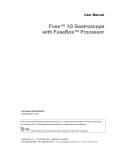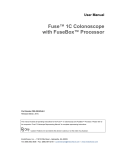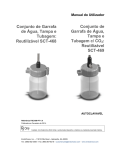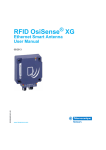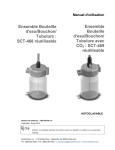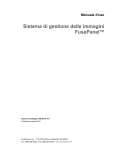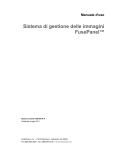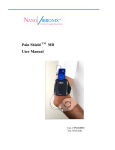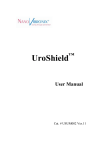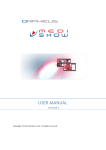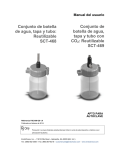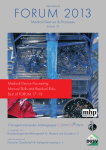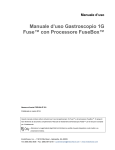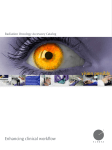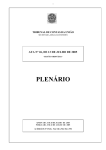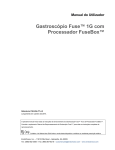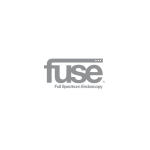Download FSE-057-EN-3.0 Fuse 1G Gastroscope Reprocessing
Transcript
Reprocessing Manual Fuse™ 1G Gastroscope Part Number FSE-057-EN-3.0 Released November, 2013. This manual includes complete reprocessing instructions for the Fuse™ 1G Gastroscope system. Please refer to the companion “Fuse™ 1G Gastroscope with FuseBox™ Processor User Manual” for complete operating instructions. Caution: Federal U.S. law restricts this device to sale by or on the order of a physician. EndoChoice, Inc. – 11810 Wills Road – Alpharetta, GA 30009 Tel: (888) 682-3636 – Fax: (866) 567-8218 – [email protected] – www.endochoice.com IMPORTANT: Read the User and Reprocessing Manuals in their entirety prior to using the Fuse™ 1G Gastroscope system. 2013 EndoChoice, Inc. ALL RIGHTS RESERVED. EndoChoice, Inc. reserves the right to alter the equipment specifications and descriptions in this publication without prior notice. No part of this publication shall be deemed to be part of any contract or warranty unless specifically incorporated by reference into such contract or warranty. The information contained herein is merely descriptive in nature, and does not constitute a binding offer for the sale of the product described herein. Neither EndoChoice, Inc. nor its agent make any representations for fitness for any purpose, other than specifically mentioned in this manual. DISCLAIMER EndoChoice, Inc. shall not be obligated in any manner in respect to bodily injury and/or property damage arising from the use of the device if such use is not in strict compliance with instructions and safety precautions contained in the relevant operating manuals and in all supplements thereto, in all product labels, and according to all terms of warranty and sale of this device, or in any change not authorized by EndoChoice, Inc. WARNING User provided ancillary equipment and/or accessories are NOT validated or warranted by EndoChoice, Inc. The use of such user provided items is the sole responsibility of the party using such items. EC ii REP EndoChoice Innovation Center Ltd. European Authorized Representative 2 Hatochen Street Caesarea, 38900, Israel Tel: +972-4-632-7731 Fax: +972-4-632-7734 Email: [email protected] MedNet GmbH Borkstraβe 10 48163 Munster, Germany Tel: +49-251-32266-0 Email: [email protected] FSE-057-EN-3.0 Contents Contents Contents ....................................................................................................... iii Safety Information – Please Read Prior to Use ................................................1 Using this manual ........................................................................................................ 1 Support........................................................................................................................ 1 Summary of instrument symbols ................................................................................. 2 Precautions ................................................................................................................. 2 Reprocessing importance............................................................................................ 5 Reprocessing before/after first use and storage .......................................................... 5 CHAPTER 1 Reprocessing the Endoscope and Accessories .............................7 1.1 Limitations on Reprocessing .............................................................................. 7 1.2 Reprocessing Accessories................................................................................. 8 1.3 1.4 1.2.1 Soaking Cap ........................................................................................ 8 1.2.2 Air/Water Cleaning Adaptor ................................................................. 9 1.2.3 Working Channel Cleaning Adaptor ..................................................... 9 1.2.4 Auxiliary Water Supply Port Cleaning Adaptor ....................................10 1.2.5 Leak Tester .........................................................................................10 1.2.6 Single-use Channel Cleaning Brush ...................................................11 1.2.7 Single-use Channel Opening Cleaning Brush .....................................11 Connecting Reprocessing Adaptors..................................................................12 1.3.1 Connecting the Air/Water Cleaning Adaptor .......................................12 1.3.2 Connecting the Working Channel Cleaning Adaptor ...........................14 1.3.3 Connecting the Auxiliary Water Supply Port Cleaning Adaptor ...........15 Required Equipment and Materials ...................................................................16 CHAPTER 2 Reprocessing Steps .................................................................. 19 2.1 Reprocessing Steps Flow Chart .......................................................................19 2.2 STEP 1: Pre-Cleaning.......................................................................................20 2.3 2.2.1 Wipe down the inserted section of the endoscope ..............................21 2.2.2 Aspirate detergent, water and air ........................................................21 2.2.3 Flush the air and water channels ........................................................21 2.2.4 Flush the Auxiliary Water Supply Channel ..........................................22 2.2.5 Disconnect system and transfer endoscope .......................................22 STEP 2: Leak Testing .......................................................................................23 2.3.1 Connecting the Leak Tester ................................................................24 2.3.2 Dry Leak test .......................................................................................24 Fuse™ 1G Gastroscope Reprocessing Manual iii Contents 2.3.3 2.4 2.5 2.6 2.7 STEP 3: Manual Cleaning.................................................................................25 2.4.1 Aspirate detergent and air through the Working Channel ...................26 2.4.2 Place the endoscope and accessories in detergent solution...............27 2.4.3 Clean the external surfaces ................................................................27 2.4.4 Brush the Air/Water and Suction Valves .............................................28 2.4.5 Brush the Suction Channel in the Umbilical Tube section ...................28 2.4.6 Brush the Suction Channel in the Insertion Tube section....................28 2.4.7 Channel cleaning brush locations .......................................................29 2.4.8 Flush the Air/Water Channels with detergent solution ........................29 2.4.9 Flush the Suction/Working Channels with Detergent Solution ............30 2.4.10 Flush the Auxiliary Water Supply Channel with Detergent Solution ....31 2.4.11 Flush the Air/Water and Suction Valves with detergent solution .........31 2.4.12 Wipe down the inserted section of the endoscope ..............................31 2.4.13 Soak in detergent solution...................................................................31 STEP 4: Rinsing after Manual Cleaning............................................................32 2.5.1 Move the endoscope and accessories from detergent to clean water 33 2.5.2 Flush the Air/Water Channels with water ............................................33 2.5.3 Flush the Suction/Working Channels with water .................................33 2.5.4 Flush the Auxiliary Water Channels with water ...................................34 2.5.5 Flush the Air/Water and Suction Valves with water.............................35 2.5.6 Remove the endoscope and accessories from the water ...................35 2.5.7 Discard the rinse water .......................................................................35 2.5.8 Flush the Air/Water Channels with air .................................................35 2.5.9 Flush the Suction/Working Channels with air ......................................36 2.5.10 Flush the Auxiliary Water Channels with air ........................................37 2.5.11 Flush the Air/Water and Suction Valves with air .................................37 2.5.12 Following the rinse ..............................................................................37 STEP 5: High-Level Disinfection .......................................................................38 2.6.1 Move the endoscope and accessories to the HLD solution.................39 2.6.2 Flush the Air/Water Channels with HLD solution ................................39 2.6.3 Flush the Suction/Working Channels with HLD solution .....................40 2.6.4 Flush the Auxiliary Water Supply Channel with HLD solution .............40 2.6.5 Flush the Air/Water and Suction Valves with HLD solution .................41 2.6.6 Soak in HLD solution...........................................................................41 STEP 6: Final Rinsing .......................................................................................42 2.7.1 iv Wet Leak test ......................................................................................24 Prepare endoscope and accessories for removal from HLD solution .43 FSE-057-EN-3.0 Contents 2.8 2.9 2.7.2 Remove the endoscope and accessories from HLD solution ..............44 2.7.3 Flush the Air/Water Channels with water ............................................44 2.7.4 Flush the Suction/Working Channels with sterile water.......................45 2.7.5 Flush the Auxiliary Water Channels with water ...................................46 2.7.6 Flush the Air/Water and Suction Valves with water .............................46 2.7.7 Remove the endoscope and accessories from sterile water ...............46 2.7.8 Wipe down external surfaces ..............................................................46 2.7.9 Flush the Air/Water Channels with air .................................................47 2.7.10 Flush the Suction/Working Channels with air ......................................47 2.7.11 Flush the Auxiliary Water Channels with air ........................................48 2.7.12 Flush the Air/Water and Suction Valves with air .................................48 2.7.13 Flush the Air/Water Channels with alcohol..........................................49 2.7.14 Flush the Suction/Working Channels with alcohol ..............................49 2.7.15 Flush the Auxiliary Water Channels with alcohol ................................50 2.7.16 Flush the Air/Water and Suction Valves with alcohol ..........................50 2.7.17 Wipe down external surfaces with alcohol ..........................................51 STEP 7: Drying .................................................................................................52 2.8.1 Dry the endoscope, accessories and cleaning equipment ..................52 2.8.2 Store the endoscope ...........................................................................52 Processing Steps Summary Chart ....................................................................55 CHAPTER 3 Storage and Disposal ............................................................... 59 3.1 Storage between uses ......................................................................................59 3.2 Disposal of accessories and reprocessing supplies ..........................................60 Fuse™ 1G Gastroscope Reprocessing Manual v Contents This page intentionally left blank vi FSE-057-EN-3.0 Safety Information – Please Read Prior to Use Safety Information – Please Read Prior to Use Using this manual This reprocessing manual provides information required to enable you to reprocess the Fuse™ 1G Gastroscope. Read this manual thoroughly before using the device and ensure you understand the proper use and care of the device. If you have any questions or comments regarding the use of the device, please contact EndoChoice, Inc. Note that the complete instruction manual set for this endoscope also includes the companion “Fuse™ 1G Gastroscope with FuseBox™ Processor User Manual”. For illustration purposes, the Fuse™ 1C Colonoscope is pictured throughout this manual. Keep this reprocessing manual in a safe and accessible location. The following conventions are used in this manual: Symbol Description WARNING CAUTION: A warning is a statement that alerts / indicates a potentially hazardous situation associated with the use or misuse of the device, which, if not avoided, could result in serious injury or death. A caution is a statement that alerts / indicates a potentially hazardous situation associated with its use or misuse which may, if not avoided, result in minor or moderate injury. It may also be used to alert against unsafe practices or potential equipment damage. An informational note provides additional information of interest to the user. Support Outside the United States United States EndoChoice GmbH Otto-Hahn-Str. 11 25337 Elmshorn Germany EndoChoice, Inc. 11810 Wills Rd. Alpharetta, GA 30009 USA +49 (0) 4121-649390 Phone +49 (0) 4121-649383 Fax 888-682-ENDO (3636) Phone 866-567-8218 Fax Fuse™ 1G Gastroscope Reprocessing Manual 1 Safety Information – Please Read Prior to Use Summary of instrument symbols Symbol Description Serial number Consult instructions for use Attention, see instructions Manufactured by EC REP European Representative Federal US law restricts this device for sale by or on the order of a physician. Non Sterile Catalog Number Number of units Precautions WARNING Read all warnings thoroughly. Failure to observe the following warnings may cause device damage and/or result in patient or user cross-contamination, infection, or injury. The following manual cleaning and high-level disinfection instructions have been validated. Failure to follow all steps may result in an infection control risk to patients and/or operators. 2 Improper reprocessing may result in patient cross-contamination and/or infection. FSE-057-EN-3.0 Safety Information – Please Read Prior to Use The endoscope was not cleaned and high-level disinfected before shipping. It must be cleaned and high-level disinfected prior to first use. Always examine the device and confirm that there are no observable abnormalities or defect before reprocessing. Do not reprocess if any abnormality or defect is found. Prior to each procedure, confirm that the endoscope has undergone proper cleaning and disinfection, and if in doubt reprocess again according to the instructions provided in this manual. Every channel of the endoscope must go through every reprocessing step and must be reprocessed each time the endoscope is used, even if the channel was not utilized during the procedure. Failure to do so may result in patient crosscontamination and/or infection. To receive the latest list of Automated Endoscope Reprocessors (AERs) in which the Fuse™ 1G system has been validated for disinfection, please contact your local EndoChoice representative. The Fuse™ 1G system has not been validated to be used with ultrasonic cleaners. Do not reprocess the device in any ultrasonic cleaner as this may result in cross contamination or damage to the device. Do not steam sterilize the endoscope; steam sterilization will severely damage the endoscope. The product and ancillary equipment must be inspected before each use for deformed parts or tips. Do not use the endoscope or ancillary equipment if any irregularity is suspected. If a problem is observed or suspected, contact your EndoChoice representative. Patient debris and reprocessing chemicals are hazardous. Wear personal protective equipment to guard against dangerous chemicals and potentially infectious materials. During cleaning and disinfection wear appropriate personal protective equipment such as eyewear, facemask, moisture-resistant clothing, and long sleeve chemical resistant gloves. Always remove contaminated personal protective equipment before leaving the reprocessing area, and ensure the reprocessing room is adequately ventilated and lighted. Thoroughly rinse off the disinfectant solution. Rinse the external surface of the endoscope, all channels, and the cleaning equipment thoroughly with water to remove any disinfectant solution residuals. Avoid the use of metallic brushes, scrub pads, or other articles that may damage the instrument. Chemicals such as organic or ammoniated acids or solvents that are likely to damage the instrument must not be used. Fuse™ 1G Gastroscope Reprocessing Manual 3 Safety Information – Please Read Prior to Use When reprocessing the endoscope confirm that the water resistance cap is securely attached to the endoscope before immersion in fluids. Failure to follow this instruction may result in damage to the equipment. Be sure to perform a leak test on the endoscope prior to reprocessing, and do not use the endoscope if a leak has been detected. Use of an endoscope with a leak may result in product malfunction. Establish an internal method of identifying and separating contaminated versus reprocessed endoscopes and accessories. Pay particular attention to avoid exposing reprocessed endoscopes and/or accessories with contaminated gloves or surfaces. Failure to effectively separate reprocessed from contaminated materials may result in patient cross-contamination or infection. When using the product on a patient with CJD (Creutzfeldt–Jakob disease) or vCJD (variant Creutzfeldt–Jakob disease), be sure to use this product only once for such patient and immediately dispose of the product after use in an appropriate manner. For methods to handle CJD, please follow the respective guidelines in your country. This instrument does not have sufficient durability against the methods stated in the guidelines of each country for destroying or inactivating prions. For information on the durability against each method, please contact EndoChoice. The endoscope’s auxiliary buttons cannot be removed from the control section. Pressing, pulling, or twisting them with excessive force can break the buttons and/or cause water leaks. If the endoscope is not cleaned meticulously, effective high-level disinfection may not be possible. Clean the endoscope and accessories thoroughly before high level disinfection to remove microorganisms or organic material that could reduce the efficacy of disinfection. EndoChoice only confirms validation of the endoscope reprocessing procedure described in this manual. Use of other reprocessing procedures or AERs has not been validated and their use may fail to result in effective cleaning and high-level disinfection. Store alcohol in an air-tight container. Alcohol stored in an open container is a fire hazard and will result in a loss of efficacy due to evaporation. Disposable accessories: Do not attempt to reprocess and reuse disposable accessories. After use discard according to the manufacturer instructions and per all applicable national and local laws and guidelines. CAUTION: Before each procedure, inspect the endoscope and accessories for damage according to instructions described in the “Fuse™ 1G Gastroscope with FuseBox™ Processor User Manual”. 4 FSE-057-EN-3.0 Safety Information – Please Read Prior to Use The endoscope is made of plastic materials. Take special care not to scratch/puncture the endoscope with any sharp edge components such as endoscopy tools, as this can result in equipment damage and leaks. Pay particular attention to avoid damaging the Bending Section. Do not immerse the endoscope with any objects that are not used for reprocessing the endoscope, as this can damage the endoscope. Do not apply lubricants to the Air/Water Channel cleaning adapter as this may result in a malfunction. Flush the Air/Water Channels during the Pre-Cleaning stage to reduce the possibility of Air/Water nozzles blockage. Reprocessing importance Improper reprocessing may result in contamination. It is strongly recommended that all individuals involved in the reprocessing of the device comply with all instructions given in this manual and have a comprehensive understanding of the following items: Routine practices and additional safety guidelines of the facility Appropriate use of personal protective equipment Occupational health and safety regulations related to reprocessing Reprocessing procedures and internal structure of flexible endoscopes and its accessories Safe handling and proper disposal of chemicals used in reprocessing Appropriate selection of cleaning and disinfecting methods must be taken into consideration with the applicable policies at your facility, applicable national laws and standards, and professional society guidelines. Reprocessing before/after first use and storage This Fuse™ 1G Gastroscope was not reprocessed before shipment. Before first time use, reprocess the device according to the reprocessing manual. After use, reprocess and store it according to the storage instructions provided in this manual. Improper and/or incomplete reprocessing or storage can result in contamination, equipment damage, or a reduction in performance. Fuse™ 1G Gastroscope Reprocessing Manual 5 Safety Information – Please Read Prior to Use This page intentionally left blank 6 FSE-057-EN-3.0 Reprocessing the Endoscope and Accessories CHAPTER 1 Reprocessing the Endoscope and Accessories These instructions were validated for reprocessing the endoscope and the endoscope accessories. These reprocessing instructions have been validated by EndoChoice as being able to prepare the device for safe and effective re-use. 1.1 Limitations on Reprocessing Reprocessing in any AER requires validation. Contact EndoChoice for the most updated list of validated AERs for reprocessing the Fuse™ 1G system. Do not reprocess the Fuse™ 1G system in any other AER. Proper reprocessing has a minimal effect on the device degradation. The end of the device’s life is normally determined by wear and damage due to use. Do not leave the device in solutions longer than necessary, as this may accelerate the normal product aging and may result in patient injury. Damage incurred by improper reprocessing will not be covered by the warranty. Detergent solution refers to enzymatic or neutral pH detergent indicated for use with flexible endoscopes. Fuse™ 1G Gastroscope Reprocessing Manual 7 Reprocessing the Endoscope and Accessories 1.2 Reprocessing Accessories Reprocessing accessories, functional features, and inspection instructions are provided in this section. The following table provides catalog and model numbers for the Fuse™ Reprocessing Adaptor Kit: Catalog Number Description Endoscope Reprocessing Adaptor Kit: FSR-3300-KT FSR-2001 Air/Water Suction Cleaning Adapter Working Channel Cleaning Adaptor Auxiliary Water Supply Port Cleaning Adaptor Soaking Cap (also available separately, see below) Soaking Cap 1.2.1 Soaking Cap Functionality The Soaking Cap is used to seal the Video Socket (Video Input Socket) on the endoscope during leak testing and reprocessing steps. The Soaking Cap is attached to the Main Connector video interface. Inspection Visually confirm that the Soaking Cap is dry and free of debris. Visually confirm that the O-Ring seals are intact. CAUTION: If the Main Connector external surface is damaged, it may no longer be waterproof and leak can occur, damaging the electronics in subsequent use; if the connector is damaged, do not use the endoscope and immediately contact EndoChoice (see Support on page 1). 8 FSE-057-EN-3.0 Reprocessing the Endoscope and Accessories 1.2.2 Air/Water Cleaning Adaptor Functionality The Air/Water Cleaning Adaptor is used to allow direct flushing of the Air/Water Channels of the endoscope. For more details, refer to Section 1.3.1Connecting the Air/Water Cleaning Adaptor. Inspection Visually confirm that the Air/Water Cleaning Adaptor is dry and free of debris. Visually confirm that the two O-Ring seals are intact. Confirm that both Luer caps are in place. 1.2.3 Working Channel Cleaning Adaptor Functionality The Working Channel Cleaning Adaptor is used for adaptation of the syringe to the Working Channel (also known as the Biopsy Port) of the endoscope, allowing direct flushing of the Working Channel. For more details refer to Section 1.3.2, Connecting the Working Channel Cleaning Adaptor. Inspection Visually confirm that the Working Channel Cleaning Adaptor is dry and free of debris. Visually inspect that the adaptor is not scratched or deformed. Fuse™ 1G Gastroscope Reprocessing Manual 9 Reprocessing the Endoscope and Accessories 1.2.4 Auxiliary Water Supply Port Cleaning Adaptor Functionality The Auxiliary Water Supply Port Cleaning Adaptor is used for adaptation of the syringe to the Auxiliary Water Supply Port of the endoscope, allowing direct flushing of the Auxiliary Water Channels. For more details refer to Section 1.3.3, Connecting the Working Channel Cleaning Adaptor. Inspection Visually confirm that the Auxiliary Water Supply Port Cleaning Adaptor is dry and free of debris. Visually inspect that the adaptor is not scratched or deformed. 1.2.5 Leak Tester Functionality The Leak Tester is used to test the endoscope for sealing integrity. The Leak Tester is connected to the endoscope Main Connector. For more details, refer to step 2 – Leak Test. 10 Inspection Visually confirm that the silicone tube is firmly attached to the Leak Tester on both sides. Visually confirm that all plastic parts are intact. FSE-057-EN-3.0 Reprocessing the Endoscope and Accessories 1.2.6 Single-use Channel Cleaning Brush Functionality Inspection The Single-use Channel Cleaning Brush is used to brush the inside of the instrument channel and Suction Channel of the endoscope. Use a non-metal single-use channel cleaning brush suited for 2.8 mm channels such as: EndoChoice’s HedgeHog SingleEnd Channel Brush (SBS-227-50) or the HedgeHog Double-End Channel Brush (SBD-228-50). Refer to the manufacturer’s instructions. 1.2.7 Single-use Channel Opening Cleaning Brush Functionality Inspection The single-use channel opening cleaning brush is used to brush the suction cylinder and the instrument channel port of the endoscope. Use a non-metal single-use channel opening cleaning brush such as the HedgeHog Valve Brush (SBB-119-50) by EndoChoice. Refer to the manufacturer’s instructions. Fuse™ 1G Gastroscope Reprocessing Manual 11 Reprocessing the Endoscope and Accessories 1.3 Connecting Reprocessing Adaptors 1.3.1 Connecting the Air/Water Cleaning Adaptor Below is the step-by-step explanation of how to connect and operate the Air/Water Cleaning Adaptor. The correct adaptors are to be used in order to ensure proper flushing of all channels. Failure to attach the adaptor may result in improper reprocessing. The Air/Water Cleaning Adaptor is used to allow access to the Air/Water and suction ports on the Control Handle. 12 1. Disassemble the Air/Water and Suction Valves from the Control Handle. 2. Open the Air/Water Cleaning Adaptor lever. 3. Place the Air/Water Cleaning Adaptor onto the Air/Water and Suction ports. FSE-057-EN-3.0 Reprocessing the Endoscope and Accessories 4. Secure the Air/Water Cleaning Adaptor on the Control Handle by closing the lever. The Air/Water Cleaning Adaptor has a Luer interface to allow connection to Luer-Lock syringes during reprocessing steps. To use the Luer port, perform the following: 5. Unscrew the two cap screws located on the Air/Water Cleaning Adaptor. 6. Connect the syringe to the Luer connector. Fuse™ 1G Gastroscope Reprocessing Manual 13 Reprocessing the Endoscope and Accessories 7. Replace the cap screws on the Air/Water Cleaning Adaptor after use of the syringe. 8. To remove the Air/Water Cleaning Adaptor from the Control Body, open the lever on the Air/Water Cleaning Adaptor. 1.3.2 Connecting the Working Channel Cleaning Adaptor Below is the step-by-step explanation of how to connect the Working Channel Cleaning Adaptor. The correct Working Channel Cleaning Adaptors are to be used in order to properly flush the working channels. Failure to attach the Working Channel Cleaning Adaptor may result in improper reprocessing. The term Working Channel Cleaning Adaptor in the reprocessing instructions refers to the Biopsy Cap attached to the silicone tube. Use a new syringe for each reprocessing step. 1. Connect the Working Channel Cleaning Adaptor silicone tube to the Working Channel Cleaning Adaptor. 2. Connect a syringe to the silicone tube by twisting it in the Luer lock thread; verify the connection is sealed. 14 FSE-057-EN-3.0 Reprocessing the Endoscope and Accessories 3. When required, connect the Working Channel Cleaning Adaptor to the Working Channel on the Control Handle; verify proper connection by twisting the adaptor on the Working Channel. 1.3.3 Connecting the Auxiliary Water Supply Port Cleaning Adaptor 1. Connect the Auxiliary Water Supply Port Cleaning Adaptor to the Auxiliary Water Supply Port by twisting clockwise until tight. 2. Connect a syringe to the silicone tube by twisting it in the Luer lock thread; verify the connection is sealed. Fuse™ 1G Gastroscope Reprocessing Manual 15 Reprocessing the Endoscope and Accessories 1.4 Required Equipment and Materials The following equipment and materials are required for reprocessing. The items listed below – including cleaning agents (responsible for removal of soil), disinfecting agents (responsible for reduction of microbes) and rinsing water (responsible for removal of agent residuals) – were validated and demonstrated to be compatible with the device and to meet the predefined reprocessing performance criteria. Replace any of the reusable equipment listed below that shows signs of wear prior to reprocessing. Equipment Description Important Eyewear, facemask, moisture-resistant clothing, and long chemical resistant gloves. Ensure the reprocessing room is adequately ventilated and lighted. Personal Protective Equipment Clean LintFree Cloths Sterile LintFree Cloths Detergent Solution Clean lint-free cloth may be used for all reprocessing steps except the final drying step. A new, sterile lint-free cloth MUST be used during final drying step, and it may be used for all reprocessing steps. Use a medical grade, low foaming, neutral pH or enzymatic detergent indicated for use with flexible endoscopes such as: Pure™ (by EndoChoice), which is indicated for use with flexible endoscopes. Follow the manufacturer’s recommendations, including personal protection to be used, dilution, temperature, immersion duration, storage, date of expiration, disposal, etc. Rinsing Water – Sterile Rinsing Water – Potable Tap Syringe (Luer Lock) 16 Sterile Water MUST be used for final rinsing step (STEP 6). Temperature: 22 - 30 ˚C (71.6 - 80.6 F) Minimum required volume: 20 Liters Clean potable tap water may be used for all other cleaning steps. Temperature: 22 - 30 ˚C (71.6 - 80.6 F) Minimum required volume: 20 Liters DO NOT REUSE DETERGENT SOLUTION! Solution should be replaced after being used to reprocess one endoscope. DO NOT REUSE RINSING WATER! Water should be replaced after being used to reprocess one endoscope. DO NOT REUSE RINSING WATER! Water should be replaced after being used to reprocess one endoscope. Single-use sterile 30 ml syringe – at least 10 units. FSE-057-EN-3.0 Reprocessing the Endoscope and Accessories Equipment Description Important Use an FDA-cleared/CE-marked high level disinfectant, like Cidex® OPA (by Advanced Sterilization Products). Follow the manufacturer’s recommendations, including personal protection to be used, dilution, temperature, immersion duration, storage, date of expiration, disposal etc. If the disinfectant solutions are reused, routinely check their efficiency with test strips according to the manufacturer recommendations. Do not use solutions beyond their expiration date. Test disinfectant MEC (Minimal Effective Concentration) routinely. 70% alcohol Ethanol should be stored in closed container to avoid evaporation. Alcohol is not a sterilant or high-level disinfectant. DO NOT REUSE ALCOHOL! Basins Containers, sinks, and basins should be large enough so the endoscope is not damaged by being coiled too tightly. Minimum recommended basin dimension is 40 cm X 40 cm x 15 cm / 16” x 16” x 6”. The basin should have a tight-fitting lid if it is also used for high-level-disinfection. Number of basins required is five (5): (1) Used during Leak Test (Water) (1) Used during Manual Cleaning (Detergent) (1) Used during Manual Cleaning (Water) (1) Used during High-level Disinfection (Disinfectant) (1) Used during Rinsing (Sterile Water) Transportation Containers or Pads It is recommended that the endoscope is transported in a closed container or closed transport pad (such as the EndoChoice CinchPad®) to prevent contamination or equipment damage during transport. A 40 cm X 40 cm x 15 cm / 16” x 16” x 6” container may be used. Pre – cleaning containers Two (2) 500ml containers are needed for aspirating detergent and water in the PreCleaning stage. Suction pump Suction pumps such as a Basic 30 Suction Pump by Medela or equivalent is necessary for detergent aspiration during the manual cleaning step. Use appropriate tube set. Disinfectant Solution Fuse™ 1G Gastroscope Reprocessing Manual 17 Reprocessing the Endoscope and Accessories This page intentionally left blank 18 FSE-057-EN-3.0 Reprocessing Steps CHAPTER 2 Reprocessing Steps 2.1 Reprocessing Steps Flow Chart Fuse™ 1G Gastroscope Reprocessing Manual 19 Reprocessing Steps 2.2 STEP 1: Pre-Cleaning The initial steps in the cleaning process begin immediately after the patient procedure at the point of use, as this step must be done while the scope is connected to FuseBox™ Processor and the system is still connected to the water bottle and suction source. WARNING After use, immediately discard the Biopsy Valve according to local regulations, as it is a single use accessory. For a reusable Biopsy Valve, discard or reuse the valve according to local regulations, and according to the manufacturer’s instructions for use. Not following this instruction could result in cross contamination between patients. Immediate flushing of the channels prevents drying of organic and inorganic debris on lumen surfaces and may remove large numbers of microorganisms. The table below lists the Fuse™ 1G components and required equipment/materials for Pre-Cleaning: Reprocessing Step #1 Pre-Cleaning Location Procedure Room Fuse™ 1G Components for Fuse™ 1G Reprocessing Step #1 Air/Water Valve (assembled) Suction Valve (assembled) Equipment needed for this step Equipment Specified Brand/Model/Type Personal protective equipment 30ml syringe (x3) Clean Lint-free cloth Use a cloth or sponge, like Koala® (by EndoChoice). 500 ml container (x2) Transportation container or transportation pad Container: 40 cm X 40 cm x 15 cm / 16” x 16” x 6” Pad: CinchPad® (by EndoChoice) 500ml Clean water Clean, potable water 22 - 30 ˚C 500ml Detergent solution Use an enzymatic detergent, like Pure™ (by EndoChoice) which is indicated for use with flexible endoscopes. Video processor FuseBox™ Soaking Cap EndoChoice Perform the following steps immediately after the procedure – at the point of use: 20 FSE-057-EN-3.0 Reprocessing Steps 2.2.1 Wipe down the inserted section of the endoscope 1. Thoroughly wipe the Insertion Tube, Bending Section and Distal Tip with a clean soft lint-free cloth soaked in detergent. 2.2.2 Aspirate detergent, water and air 2. Immerse the Distal Tip in a container with detergent solution and activate the suction by pressing the Suction Valve down for a minimum of 30 seconds. 3. Immerse the Distal Tip in a container with clean water and activate the suction by pressing the Suction Valve down for a minimum of 30 seconds. 4. Remove the Distal Tip from the water. 5. Activate the suction by pressing the Suction Valve down for a minimum of 30 seconds. 2.2.3 Flush the air and water channels 1. Immerse the Distal Tip in clean water. 2. Turn the pump to its highest setting. 3. Activate the air flow by covering the hole on the Air/Water Valve for 30 seconds. Visually verify air emits from both Air and Water nozzles; if any of the nozzles appear blocked contact EndoChoice. 4. Activate the water flow by depressing the Air/Water Valve for 30 seconds. Fuse™ 1G Gastroscope Reprocessing Manual 21 Reprocessing Steps 2.2.4 Flush the Auxiliary Water Supply Channel 1. Open the Auxiliary Water Port Cap. 2. Connect the Auxiliary Water Supply Port Cleaning Adaptor to the Auxiliary Water Supply Port. 3. Connect a syringe filled with a detergent solution to the Auxiliary Water Supply Port Cleaning Adaptor, and slowly flush 30ml of the detergent solution through the Auxiliary Water Channel. 4. Connect a syringe filled with water to the Auxiliary Water Supply Port Cleaning Adaptor, and slowly flush the water through the Auxiliary Water Channel. Repeat this process a minimum of 3 times. 5. Connect a syringe filled with air to the Auxiliary Water Supply Port Cleaning Adaptor, and slowly flush air through the Auxiliary Water Channel. Repeat this step until a steady stream of air (with no water) exits the channel. 2.2.5 Disconnect system and transfer endoscope 1. Turn the FuseBox™ Processor off. 2. Remove all detachable parts attached to the endoscope’s interfaces: Suction Valve, Air/Water Valve, and Biopsy Valve. 3. Soak the Air/Water and Suction Valves in detergent solution. 4. Discard or reuse the Biopsy Valve per its manufacturer instruction for use. 5. Ensure that the Soaking Cap is dry; attach the Soaking Cap onto the Video Socket (Video Input Socket) by placing the notches on the Video Socket (Video Input Socket) in the holes on the Soaking Cap and twisting the Soaking Cap to align the red dots. 6. Immediately transport the endoscope and valves in a covered container to the reprocessing area. 22 FSE-057-EN-3.0 Reprocessing Steps 2.3 STEP 2: Leak Testing The leak test detects physical breaks in the exterior or interior of the endoscope. Physical breaks compromise the integrity of the endoscope and expose the internal structures (i.e., electronics, manipulation cables, etc.) of the endoscope, to damage during reprocessing, as these internal components are not meant to be in contact with fluids. WARNING If a leak is detected in the Fuse™ 1G, do not use the device! Remove the endoscope from service and contact EndoChoice immediately. CAUTION: Do not disconnect the Soaking Cap while the device is submerged in water, as this may result in endoscope damage. Do not place the gauge/hand pump of the Leak Tester in liquid. Be sure to fully rotate the Leak Tester connector onto the Leak Tester port. If the connector is not fully attached, a leak test cannot be performed. A slight, one-time drop in pressure may be observed during leak testing and does not indicate there is a leak. A leak will be observed as pressure drops over time. The table below lists the Fuse™ 1G components and required equipment and materials for leak testing: Reprocessing Step #2 Leak Testing Location Reprocessing Room Fuse™ 1G Components for Fuse™ 1G Reprocessing Step #2 Soaking Cap Equipment needed for this step Equipment Specified Brand/Model/Type Personal protective equipment Leak Tester EndoChoice Basin 40x40x15 cm/ 16” x 16”x 6” Clean water Clean, potable water 22 - 30 ˚C Fuse™ 1G Gastroscope Reprocessing Manual 23 Reprocessing Steps 2.3.1 Connecting the Leak Tester 1. Ensure the Soaking Cap is firmly attached to the Video Socket (Video Input Socket). 2. Visually confirm that both the Leak Tester and the Leak Tester ports are dry. 3. Connect the Leak Tester to the endoscope by sliding the notch on the Auxiliary Water Supply Port into the opening on the Leak Tester port. Twist the connector clockwise to securely close the connection. 2.3.2 Dry Leak test 1. Inflate the Leak Tester to 240 mmHg. 2. Observe the Leak Tester dial closely for a minimum of 30 seconds while angulating the Bending Section. Verify that the pressure does not drop. This indicates that there are no leaks, and that a wet (water) leak test can be performed next. 2.3.3 Wet Leak test 1. Prepare a basin with clean water. 2. Completely submerge the endoscope in water while the endoscope is still pressurized. 3. Observe the Leak Tester dial closely for a minimum of 30 seconds while angulating the Bending Section. Verify that the pressure does not drop. 4. Check the Insertion Tube, the Distal Bending Section, and the Umbilical Tube to confirm there is no continuous stream of air bubbles emerging which would indicate a leak in the endoscope. 5. 24 Remove the endoscope from the basin. FSE-057-EN-3.0 Reprocessing Steps 2.4 STEP 3: Manual Cleaning Manual cleaning refers to the physical removal of organic material and soil. WARNING Read all warnings thoroughly. Failure to observe the following warnings may cause device damage and/or result in patient or user cross-contamination, infection, or injury. The scope must remain immersed during the cleaning process to prevent splashing of contaminated fluid, especially when brushes are being pulled out. Brush channels thoroughly. Inadequate brushing of the channels may pose an infection-control risk to a subsequent patient and/or operator. Use of excessive force may damage or deform the single-use brushes during cleaning. During and after use, ensure that the brush integrity has not been compromised. Should part of the brush come off inside the scope, immediately retrieve it and confirm removal. If in doubt, immediately call EndoChoice for service and do not use the device as the brush part my cause patient infection or injury. Do not attempt to reuse single-use brushes. Discard immediately after use according to local regulations and manufacturer’s instructions. The adequate time and temperature parameters for cleaning are critical, therefore, temperature should be monitored and contact time should be measured per manufacturer recommendations. The use of a time and thermometer should be considered. Cleaning of ancillary equipment, such as the Air/Water Valve and Suction Valve, should also include active brushing; failure to actively brush ancillary equipment could lead to cross-contamination or cause an infection control risk. Clean only one endoscope at a time, as cleaning multiple endoscopes can reduce the detergent effectiveness and cause an infection control risk. CAUTION: Insert the cleaning brush only from the Control Handle toward the Distal Tip; do not attempt to insert the brush in the Distal End. This can damage the brush and potentially cause the brush to break inside the endoscope. When inserting the Channel Opening Cleaning Brush into the Suction Port, do not forcibly insert the brush. When brushing, make sure not to scratch the seals on the Air/Water and Suction Valves. “Ancillary equipment” and “endoscope accessories” refer to the following: the Air/Water Valve and Suction Valve. Fuse™ 1G Gastroscope Reprocessing Manual 25 Reprocessing Steps The table, below, lists the components to be reprocessed and corresponding equipment and materials to be used during manual cleaning: Reprocessing Step #3 Manual Cleaning Location Reprocessing Room Fuse™ 1G Components for Fuse™ 1G Reprocessing Step #3 Air/Water Valve (disassembled) Suction Valve (disassembled) Soaking Cap Air/Water Cleaning Adaptor Working Channel Cleaning Adaptor Equipment needed for this step Equipment Specified Brand/Model/Type Personal protective equipment 30ml syringe Clean lint-free cloth (new) Use a cloth or sponge, like Koala® (by EndoChoice). Detergent solution Use an enzymatic detergent, like Pure™ (by EndoChoice), which is indicated for use with flexible endoscopes. Brush - Non-metal single-use 3.8 mm channel cleaning brush HedgeHog Single-End Channel Brush (SBS-22750, by EndoChoice), or HedgeHog Double-End Channel Brush (SBD-228-50, by EndoChoice) Brush - Non-metal single-use channel opening cleaning brush HedgeHog Valve Brush (SBB-119-50, by EndoChoice) Suction pump Use a suction pump with a tube set that suctions at rates up to 30L/min Basin (x2) 40x40x15 cm Air/Water Cleaning Adaptor EndoChoice Working Channel Cleaning Adaptor EndoChoice Soaking Cap EndoChoice Immediately after successfully carrying out the Leak test, perform the following steps: 2.4.1 Aspirate detergent and air through the Working Channel 1. Prepare the suction pump for operation. 2. Fill a basin with detergent solution at the temperature and concentration recommended by the detergent manufacturer. 26 3. Connect the Air/Water Cleaning Adaptor. Verify that the Luer caps are screwed on. 4. Connect the suction pump to the Suction Port on the Main Connector. 5. Operate the suction pump. 6. Insert the Distal Tip to the detergent. FSE-057-EN-3.0 Reprocessing Steps 7. Using your finger cover the Working Channel for at least 30 seconds to allow aspiration. 3 4 7 6 8. Remove the Distal Tip from detergent. 9. Using your finger cover the Working Channel for at least 30 seconds to allow aspiration. 2.4.2 Place the endoscope and accessories in detergent solution 1. Completely immerse the endoscope in detergent solution. 2. Remove all cleaning adaptors from the endoscope. 2.4.3 Clean the external surfaces Using a clean lint-free cloth, thoroughly wipe down all external surfaces of the endoscope. Wipe the scope in a circular motion and remove all debris from the exterior. Pay particular attention to the Air/Water nozzle openings and the objective lenses, and ensure that all the surfaces of the distal end are thoroughly cleaned, being careful not to scratch them. Fuse™ 1G Gastroscope Reprocessing Manual 27 Reprocessing Steps 2.4.4 Brush the Air/Water and Suction Valves 1. Immerse the Air/Water and Suction Valves in detergent solution. 2. Using the single-use channel opening cleaning brush, clean the valves thoroughly inside and out. 3. Brush the Air/Water Valve opening using the channel opening cleaning brush and detergent solution. 4. Repeat Step 3 a minimum of five times. 5. Allow the valves to soak in the detergent solution for as long as recommended by the detergent solution manufacturer. 2.4.5 Brush the Suction Channel in the Umbilical Tube section 1. Insert the 2.8mm cleaning brush straight into the Suction opening and feed the brush through the Umbilical Tube until it emerges from the Main Connector of the endoscope; carefully pull the brush back through the channel. 2. Brush the Suction opening using the channel opening cleaning brush and detergent solution. 3. Insert the 2.8mm cleaning brush into the Suction Channel opening and feed the brush through the Working Channel until it reaches the Distal Tip; carefully pull the brush back through the channel. Continue until no debris is visible on the brush. 4. Brush the Suction opening using the channel opening cleaning brush and detergent solution. 5. Repeat steps 1 through 4 a minimum of five times. 2.4.6 Brush the Suction Channel in the Insertion Tube section 1. Insert the 3.8mm cleaning brush into the Working Channel and feed the brush through the Suction Channel until it emerges from the Distal Tip of the endoscope; carefully pull the brush back through the channel. Continue until no debris is visible on the brush. 2. Brush the Working Channel using the channel opening cleaning brush and detergent solution. 3. 28 Repeat steps 1 and 2 a minimum of five times. FSE-057-EN-3.0 Reprocessing Steps 2.4.7 Channel cleaning brush locations 2.4.8 Flush the Air/Water Channels with detergent solution 1. Attach the cleaning adaptor to the Air/Water and Suction openings. For more information refer to Section 1.3.1, Connecting the Air/Water Cleaning Adaptor. 2. Fill a syringe with the detergent solution and connect the syringe to the Air/Water opening in the cleaning adaptor. 3. Block the Air/Water inlets on the Main Connector side with a gloved finger and slowly flush a minimum of 90ml of detergent solution through the Air/Water Channels. 4. Unblock the Air/Water inlets on the Main Connector side and slowly flush a minimum of 90ml of detergent solution through the Air/Water Channels. Fuse™ 1G Gastroscope Reprocessing Manual 29 Reprocessing Steps 2.4.9 Flush the Suction/Working Channels with Detergent Solution 1. Fill a syringe with the detergent solution and connect the syringe to the Suction opening in the Air/Water Cleaning Adaptor. 2. Block the suction inlet on the Main Connector side with a gloved finger and block the Working Channel. Using a syringe, slowly flush a minimum of 90ml of detergent solution through the Suction Channel. 3. Unblock the suction inlet on the Main Connector and block the Working Channel outlet on the Distal Tip. 4. Using a syringe, slowly flush a minimum of 90ml of detergent solution through the Suction Channel. 5. Attach the Working Channel Cleaning Adaptor to the Working Channel by twisting it onto the Working Channel. For more information refer to Section 1.3.2, Connecting the Working Channel Cleaning Adaptor. 6. Block the suction inlet on the Main Connector using the screw cap provided with the Air/Water Cleaning Adaptor. 7. Using a syringe, slowly flush a minimum of 90ml of detergent solution through the Working Channel. 1&2 30 3&4 5, 6 & 7 FSE-057-EN-3.0 Reprocessing Steps 2.4.10 Flush the Auxiliary Water Supply Channel with Detergent Solution 1. Connect the Auxiliary Water Supply Port Cleaning Adaptor to the Auxiliary Water Supply Port. 2. Connect a syringe filled with a detergent solution to the Auxiliary Water Supply Port Cleaning Adaptor, and slowly flush 90ml of the detergent solution through the Auxiliary Water Channel. 2.4.11 Flush the Air/Water and Suction Valves with detergent solution 1. Using a syringe, slowly flush a minimum of 90ml of detergent solution through the Suction Valve. 2. Using a syringe, slowly flush a minimum of 90ml of detergent solution through the Air/Water Valve. 2.4.12 Wipe down the inserted section of the endoscope Using a clean lint-free cloth, thoroughly wipe down all external surfaces of the endoscope. 2.4.13 Soak in detergent solution 1. Disconnect ALL cleaning attachments from the endoscope’s interfaces. 2. Allow the endoscope to soak in the detergent solution for the manufacturer’s recommended time and temperature. Fuse™ 1G Gastroscope Reprocessing Manual 31 Reprocessing Steps 2.5 STEP 4: Rinsing after Manual Cleaning Rinsing after manual cleaning is performed to ensure no detergent residuals remain in the endoscope following the manual cleaning step. WARNING Residual detergent from “Step #3 – Manual Cleaning” must be thoroughly removed by rinsing. The enzymatic detergent used for manual cleaning is a protein solution, and therefore, if rinsing is not adequate, residual protein will remain on the endoscope and accessories. Failure to thoroughly rinse the residual detergent may lead to the detergent protein being fixed on the device surface during high-level disinfection. The fixed protein may protect underlying bacteria from exposure to the disinfectant, leading to a cross-contamination or infection risk. Replace rinsing water after each individual rinse, as rinsing may not be effective if residual detergents are present. Adequate removal of detergent is achieved only when a sufficient amount of rinsing with fresh, clean water is performed. The Auxiliary Water Channel must be reprocessed even when the channel was not used during the procedure. Failure to perform this step may result in infection control risk. The table, below, lists the components to be reprocessed and corresponding equipment and materials to be used during rinsing steps after manual cleaning: Reprocessing Step #4 Rinsing after Manual Cleaning Location Reprocessing Room Fuse™ 1G Components for Fuse™ 1G Reprocessing Step #4 Air/Water Valve (dissembled) Suction Valve (dissembled) Soaking Cap Air/Water Cleaning Adaptor Working Channel Cleaning Adaptor Equipment needed for this step Equipment Recommended Brand/Model/Type Personal protective equipment 30ml syringe (x2) Clean lint-free cloth (new) 32 Water Clean, potable water 22 - 30 ˚C Basin 40x40x15 cm Air/Water Cleaning Adaptor EndoChoice Working Channel Cleaning Adaptor EndoChoice FSE-057-EN-3.0 Reprocessing Steps Soaking Cap EndoChoice 2.5.1 Move the endoscope and accessories from detergent to clean water 1. Remove the endoscope and accessories from the detergent basin. 2. Prepare a clean basin of clean, potable tap water. 3. Completely immerse the endoscope and accessories in a basin filled with clean water for rinsing. 4. Attach the Working Channel Cleaning Adaptor to the Working Channel by twisting it onto the Working Channel. For more information refer to Section 1.3.2, Connecting the Working Channel Cleaning Adaptor. 5. Attach the cleaning adaptor to the Air/Water and Suction openings. For more information, refer to Section 1.3.1, Connecting the Air/Water Cleaning Adaptor. 2.5.2 Flush the Air/Water Channels with water 1. Fill a syringe with clean water and connect the syringe to the Air/Water opening in the Cleaning Adaptor. 2. Block the Air/Water inlets on the Main Connector side with a gloved finger and slowly flush a minimum of 90ml of clean water through the Air/Water Channels. 3. Unblock the Air/Water inlets on the Main Connector side and slowly flush a minimum of 90ml of clean water through the Air/Water Channels. 2.5.3 Flush the Suction/Working Channels with water 1. Fill a syringe with water and connect the syringe to the Suction opening in the Cleaning Adaptor. Fuse™ 1G Gastroscope Reprocessing Manual 33 Reprocessing Steps 2. Block the suction inlet on the Main Connector side with a gloved finger and block the Working Channel. Using a syringe, slowly flush a minimum of 90ml of water through the Suction Channel. 3. Unblock the suction inlet on the Main Connector and block the Working Channel outlet on the Distal Tip. 4. Using a syringe, slowly flush a minimum of 90ml of water through the Suction Channel. 5. Attach the Working Channel Cleaning Adaptor to the Working Channel by twisting it onto the Working Channel. For more information, refer to Section 1.3.2, Connecting the Working Channel Cleaning Adaptor. 6. Block the suction inlet on the Main Connector and the Suction opening in the cleaning adaptor using the screw cap provided with the Air/Water Cleaning Adaptor. 7. Using a syringe, slowly flush a minimum of 90ml of water through the Working Channel. 1&2 3&4 5, 6 & 7 2.5.4 Flush the Auxiliary Water Channels with water 1. Connect the Auxiliary Water Supply Port Cleaning Adaptor to the Auxiliary Water Supply Port. 2. Connect a syringe filled with water to the Auxiliary Water Supply Port Cleaning Adaptor, and slowly flush 90ml of clean, fresh water through the Auxiliary Water Channel. 34 FSE-057-EN-3.0 Reprocessing Steps 2.5.5 Flush the Air/Water and Suction Valves with water 1. Using a syringe, slowly flush a minimum of 90ml of water through the Suction Valve. 2. Using a syringe, slowly flush a minimum of 90ml of water through the Air/Water Valve. 2.5.6 Remove the endoscope and accessories from the water 2.5.7 Discard the rinse water 2.5.8 Flush the Air/Water Channels with air 1. Fill a syringe with air and connect the syringe to the Air/Water opening in the Cleaning Adaptor. 2. Block the Air/Water inlets on the Main Connector side with a gloved finger and slowly flush a minimum of 90ml of air through the Air/Water Channels. 3. Unblock the Air/Water inlets on the Main Connector side and slowly flush a minimum of 90ml of air through the Air/Water Channels. Fuse™ 1G Gastroscope Reprocessing Manual 35 Reprocessing Steps 2.5.9 Flush the Suction/Working Channels with air 1. Fill a syringe with air and connect the syringe to the Suction opening in the Cleaning Adaptor. 2. Block the suction inlet on the Main Connector side with a gloved finger and block the Working Channel; using a syringe, slowly flush a minimum of 90ml of air through the Suction Channel. 3. Unblock the suction inlet on the Main Connector and block the Working Channel outlet on the Distal Tip. 4. Using a syringe, slowly flush a minimum of 90ml of air through the Suction Channel. 5. Attach the Working Channel Cleaning Adaptor to the Working Channel by twisting it onto the Working Channel. For more information refer to Section 1.3.2, Connecting the Working Channel Cleaning Adaptor. 6. Block the suction inlet on the Main Connector and the Suction opening in the cleaning adaptor using the screw cap provided with the Air/Water Cleaning Adaptor. 7. Using a syringe, slowly flush a minimum of 90ml of air through the Working Channel. 1&2 36 3&4 5, 6 & 7 FSE-057-EN-3.0 Reprocessing Steps 2.5.10 Flush the Auxiliary Water Channels with air 1. Connect the Auxiliary Water Supply Port Cleaning Adaptor to the Auxiliary Water Supply Port. 2. Connect a syringe filled with air to the Auxiliary Water Supply Port Cleaning Adaptor, and slowly flush 90ml of air through the Auxiliary Water Channel. 2.5.11 Flush the Air/Water and Suction Valves with air 1. Using a syringe, slowly flush a minimum of 90ml of air through the Suction Valve. 2. Using a syringe, slowly flush a minimum of 90ml of air through the Air/Water Valve. 2.5.12 Following the rinse 1. Remove all cleaning adaptors. 2. Using a clean, lint-free cloth, thoroughly wipe down all external surfaces of the endoscope and accessories. 3. Visually inspect the endoscope for any residual debris. Pay particular attention to the Insertion Tube, Bending Section, and Distal Tip. If there is any debris remaining on the endoscope, repeat all instructions in Section 2.4, STEP 3: Manual Cleaning. Fuse™ 1G Gastroscope Reprocessing Manual 37 Reprocessing Steps 2.6 STEP 5: High-Level Disinfection As cleaning alone is not adequate, the Fuse™ 1G Gastroscope must also be high-level disinfected before each procedure. WARNING Ensure appropriate personal protection equipment is worn while working with highlevel disinfectant (HLD) solutions. Failure to do so may result in injury or exposure to infection of reprocessing personnel. Refer to the HLD manufacturer’s recommendations when selecting personal protection equipment. Completely remove air bubbles from all channels. High-level disinfection cannot be completed if air bubbles are present in the endoscope channels. Incomplete highlevel disinfection may pose an infection control risk. All high-level disinfection steps should be performed with the endoscope and accessories completely immersed in the HLD solution. If they are not immersed completely, the HLD solution may not adequately contact all surfaces of the equipment, which may result in incomplete high-level disinfection. Incomplete highlevel disinfection may pose an infection control risk. CAUTION: Immerse the endoscope only for the time and at the concentration and temperature recommended by the manufacturer. Use of greater temperature, concentration of length of time can increase the wear of the endoscope. The table, below, lists the components to be reprocessed and corresponding equipment and materials to be used during high-level disinfection: Reprocessing Step #5 High-Level Disinfection Location Reprocessing Room Fuse™ 1G Components for Fuse™ 1G Reprocessing Step #5 Air/Water Valve (disassembled) Suction Valve (disassembled) Soaking Cap Air/Water Cleaning Adaptor Working Channel Cleaning Adaptor Equipment needed for this step Equipment Recommended Brand/Model/Type Personal protective equipment 30ml syringe Clean lint-free cloth Basin 38 40x40x15 cm FSE-057-EN-3.0 Reprocessing Steps Disinfectant solution Use an FDA-cleared high level disinfectant, like Cidex OPA. Air/Water Cleaning Adaptor EndoChoice Working Channel Cleaning Adaptor EndoChoice Soaking Cap EndoChoice 2.6.1 Move the endoscope and accessories to the HLD solution 1. Fill a clean basin with disinfectant solution at the temperature and concentration recommended by the disinfectant manufacturer. 2. Completely immerse the endoscope and accessories in disinfectant solution. 3. Attach the Working Channel Cleaning Adaptor to the Working Channel by twisting it onto the Working Channel. 4. Attach the cleaning adaptor to the Air/Water and Suction openings. For more information, refer to Section 1.3.1, Connecting the Air/Water Cleaning Adaptor. 2.6.2 Flush the Air/Water Channels with HLD solution 1. Fill a syringe with the disinfectant solution and connect the syringe to the Air/Water opening in the cleaning adaptor. 2. Block the Air/Water inlets on the Main Connector side with a gloved finger and slowly flush a minimum of 90ml of disinfectant solution through the Air/Water Channels. 3. Unblock the Air/Water inlet on the Main Connector side and slowly flush a minimum of 90ml of disinfectant solution through the Air/Water Channels. Fuse™ 1G Gastroscope Reprocessing Manual 39 Reprocessing Steps 2.6.3 Flush the Suction/Working Channels with HLD solution 1. Fill a syringe with disinfectant solution and connect the syringe to the Suction opening in the cleaning adaptor. 2. Block the suction inlet on the Main Connector side with a gloved finger, and block the Working Channel. Using a syringe, slowly flush a minimum of 90ml of disinfectant solution through the Suction Channel. 3. Unblock the suction inlet on the Main Connector and block the Working Channel outlet on the Distal Tip. 4. Using a syringe, slowly flush a minimum of 90ml of disinfectant solution through the Suction Channel. 5. Attach the Working Channel Cleaning Adaptor to the Working Channel by twisting it onto the Working Channel. For more information refer to Section 1.3.1, Connecting the Air/Water Cleaning Adaptor. 6. Block the suction inlet on the Main Connector and the Suction opening in the cleaning adaptor using the screw cap provided with the Air/Water Cleaning Adaptor. 7. Using a syringe, slowly flush a minimum of 90ml of disinfectant solution through the Working Channel. 1&2 3&4 5, 6 & 7 2.6.4 Flush the Auxiliary Water Supply Channel with HLD solution 1. Connect the Auxiliary Water Supply Port Cleaning Adaptor to the Auxiliary Water Supply Port. 40 FSE-057-EN-3.0 Reprocessing Steps 2. Connect a syringe filled with a HLD solution to the Auxiliary Water Supply Port Cleaning Adaptor, and slowly flush 90ml of the HLD solution through the Auxiliary Water Channel. 2.6.5 Flush the Air/Water and Suction Valves with HLD solution 1. Using a syringe, slowly flush a minimum of 90ml of disinfectant solution through the Suction Valve. 2. Using a syringe, slowly flush a minimum of 90ml of disinfectant solution through the Air/Water Valve. 2.6.6 Soak in HLD solution 1. Remove all the cleaning adaptors. 2. Using a lint-free cloth, wipe away any bubbles clinging to the endoscope’s external surfaces. 3. Cover the basin with a tight fitting lid. 4. Soak the endoscope and accessories in the basin of HLD solution for the amount of time and at the temperature recommended by the solution manufacturer. Fuse™ 1G Gastroscope Reprocessing Manual 41 Reprocessing Steps 2.7 STEP 6: Final Rinsing Rinsing after High-Level Disinfection is done to ensure that no disinfectant remains in the endoscope. Meticulous care must be used to avoid contamination of the endoscope. WARNING Adequate rinsing after high-level disinfection is critical in order to remove disinfectant residuals as they can cause tissue damage to the subsequent patient. Bacterial overgrowth within endoscope channels may result from contamination of tap water microorganism in moist channels. This may lead to patient contamination; therefore the final water rinse should be performed with sterile water. Rinsing cycles are performed in order to remove residuals of disinfectant agents. Empty basin after each subsequent use. Failure to comply with this instruction may result in patient irritation and/or injury. Ensure all contact with the high-level disinfected endoscope and accessories is via sterile equipment, surfaces and materials. Failure to do so may contaminate the device and pose an infection risk. The auxiliary Water Channel must be reprocessed even when the channel was not used during the procedure. Failure to perform this step may result in infection control risk. The table below lists the components to be reprocessed and corresponding equipment/materials to be used during final rinsing: Reprocessing Step #6 Final Rinsing Location Reprocessing Room Fuse™ 1G Components for Fuse™ 1G Reprocessing Step #6 Air/Water Valve (disassembled) Suction Valve (disassembled) Soaking Cap Air/Water Cleaning Adaptor Working Channel Cleaning Adaptor Equipment needed for this step Equipment Recommended Brand/Model/Type Personal protective equipment Sterile gloves 30ml syringe (x3) 42 Sterile, clean lint-free cloth Sterile, single-use Basin 40x40x15 cm Water Sterile water, at least 20 Liters Air/Water Cleaning Adaptor EndoChoice FSE-057-EN-3.0 Reprocessing Steps Working Channel Cleaning Adaptor EndoChoice Soaking Cap EndoChoice Alcohol 70% Ethanol 2.7.1 Prepare endoscope and accessories for removal from HLD solution 1. Uncover the high-level disinfection basin after the time recommended by the HLD solution manufacturer has elapsed. Before removing the endoscope from HLD solution perform the following: 2. Attach the Air/Water Cleaning Adaptor to the Air/Water and Suction openings. For more information refer to Section 1.3.1, Connecting the Air/Water Cleaning Adaptor. 3. Attach the Working Channel Cleaning Adaptor to the Working Channel by twisting it onto the Working Channel. 2.7.1.1 Flush the Air/Water Channels with air (before removing the endoscope from HLD solution) 1. Fill a syringe with air and connect the syringe to the Air/Water opening in the Air/Water Cleaning Adaptor. 2. Block the Air/Water inlets on the Main Connector side with a gloved finger and slowly flush a minimum of 90ml of air through the Air/Water Channels. 3. Unblock the Air/Water inlets on the Main Connector side and slowly flush a minimum of 90ml of air through the Air/Water Channels. 2.7.1.2 Flush the Suction/Working Channels with air (before removing the endoscope from HLD solution) 1. Fill a syringe with air and connect the syringe to the Suction opening in the Air/Water Cleaning Adaptor. 2. Block the suction inlet on the Main Connector side with a gloved finger and block the Working Channel; using a syringe, slowly flush a minimum of 90ml of air through the Suction Channel. 3. Unblock the suction inlet on the Main Connector and block the Working Channel outlet on the Distal Tip. 4. Using a syringe, slowly flush a minimum of 90ml of air through the Suction Channel. 5. Attach the Working Channel Cleaning Adaptor to the Working Channel by twisting it onto the Working Channel. For more information refer to Section 1.3.2, Connecting the Working Channel Cleaning Adaptor. 6. Block the suction inlet on the Main Connector and the Suction opening in the cleaning adaptor using the screw cap provided with the Air/Water Cleaning Adaptor. 7. 2.7.1.3 Using a syringe, slowly flush a minimum of 90ml of air through the Working Channel. Flush the Auxiliary Water Channels with air (before removing the endoscope from HLD solution) Using a syringe, slowly flush a minimum of 90ml of air through the Auxiliary Water Channel. Fuse™ 1G Gastroscope Reprocessing Manual 43 Reprocessing Steps 2.7.1.4 Flush the Air/Water and Suction Valves with air (before removing the endoscope from HLD solution): 1. Using a syringe, slowly flush a minimum of 90ml of air through the Suction Valve. 2. Using a syringe, slowly flush a minimum of 90ml of air through the Air/Water Valve. 2.7.2 Remove the endoscope and accessories from HLD solution 1. Fill a clean basin with fresh sterile water. CAUTION: A clean basin is required for final rinsing to ensure the endoscope does not get contaminated. It is recommended that a dedicated basin is used for this rinsing if possible. 1. Remove all the cleaning adaptors. 2. Remove the endoscope and accessories from the HLD solution. 3. Immerse the endoscope and accessories in the sterile water. 4. Attach the Working Channel Cleaning Adaptor to the Working Channel by twisting it onto the Working Channel. For more information refer to Section 1.3.2, Connecting the Working Channel Cleaning Adaptor. 5. Attach the cleaning adaptor to the Air/Water and Suction openings. For more information refer to Section 1.3.2, Connecting the Working Channel Cleaning Adaptor. Wipe down external surfaces Using a clean, sterile lint-free cloth, thoroughly wipe all external surfaces of the endoscope while in the basin of water. 2.7.3 Flush the Air/Water Channels with water 1. Fill a syringe with sterile water and connect the syringe to the Air/Water opening in the Air/Water Cleaning Adaptor. 2. Block the Air/Water inlets on the Main Connector side with a gloved finger and slowly flush a minimum of 90ml of sterile water through the Air/Water Channels. 44 FSE-057-EN-3.0 Reprocessing Steps 3. Unblock the Air/Water inlets on the Main Connector side and slowly flush a minimum of 90ml of sterile water through the Air/Water Channels. 2.7.4 Flush the Suction/Working Channels with sterile water 1. Fill a syringe with sterile water and connect the syringe to the Suction opening in the Air/Water Cleaning Adaptor. 2. Block the suction inlet on the Main Connector side with a gloved finger and block the Working Channel; using a syringe, slowly flush a minimum of 90ml of sterile water through the Suction Channel. 3. Unblock the suction inlet on the Main Connector and block the Working Channel outlet on the Distal Tip. 4. Using a syringe, slowly flush a minimum of 90ml of sterile water through the Suction Channel. 5. Attach the Working Channel Cleaning Adaptor to the Working Channel by twisting it onto the Working Channel. For more information refer to Section 1.3.2, Connecting the Working Channel Cleaning Adaptor. 6. Block the suction inlet on the Main Connector and the Suction opening in the cleaning adaptor using the screw cap provided with the Air/Water Cleaning Adaptor. 7. Using a syringe, slowly flush a minimum of 90ml of sterile water through the Working Channel. Image FPO 1&2 3&4 5, 6 & 7 Fuse™ 1G Gastroscope Reprocessing Manual 45 Reprocessing Steps 2.7.5 Flush the Auxiliary Water Channels with water 1. Connect the Auxiliary Water Supply Port Cleaning Adaptor to the Auxiliary Water Supply Port. 2. Connect a syringe filled with sterile water to the Auxiliary Water Supply Port Cleaning Adaptor, and slowly flush 90ml of sterile water through the Auxiliary Water Channel. 2.7.6 Flush the Air/Water and Suction Valves with water 1. Using a syringe, slowly flush a minimum of 90ml of sterile water through the Biopsy Valve. 2. Using a syringe, slowly flush a minimum of 90ml of sterile water through the Air/Water Valve. 2.7.7 Remove the endoscope and accessories from sterile water 1. Remove all cleaning adaptors. 2. Remove the endoscope and accessories from the sterile water basin. 2.7.8 Wipe down external surfaces 1. Using a sterile, clean lint-free cloth, thoroughly wipe all external surfaces of the endoscope. 2. 46 Connect the Air/Water, Suction and Working Channel Cleaning Adaptors. FSE-057-EN-3.0 Reprocessing Steps 2.7.9 Flush the Air/Water Channels with air 1. Fill a syringe with air and connect the syringe to the Air/Water opening in the Air/Water Cleaning Adaptor. 2. Block the Air/Water inlets on the Main Connector side with a gloved finger and slowly flush a minimum of 90ml of air through the Air/Water Channels. 3. Unblock the Air/Water inlets on the Main Connector side and slowly flush a minimum of 90ml of air through the Air/Water Channels. 2.7.10 Flush the Suction/Working Channels with air 1. Fill a syringe with air and connect the syringe to the Suction opening in the cleaning adaptor. 2. Block the suction inlet on the Main Connector side with a gloved finger, and block the Working Channel. Using a syringe, slowly flush a minimum of 90ml of air through the Suction Channel. 3. Unblock the suction inlet on the Main Connector and block the Working Channel outlet on the Distal Tip. 4. Using a syringe, slowly flush a minimum of 90ml of air through the Suction Channel. 5. Attach the Working Channel Cleaning Adaptor to the Working Channel by twisting it onto the Working Channel. For more information refer to Section 1.3.2, Connecting the Working Channel Cleaning Adaptor. 6. Block the suction inlet on the Main Connector and the Suction opening in the cleaning adaptor using the screw cap provided with the Air/Water Cleaning Adaptor. Fuse™ 1G Gastroscope Reprocessing Manual 47 Reprocessing Steps 7. Using a syringe, slowly flush a minimum of 90ml of air through the Working Channel. 1&2 3&4 5, 6 & 7 2.7.11 Flush the Auxiliary Water Channels with air 1. Connect the Auxiliary Water Supply Port Cleaning Adaptor to the Auxiliary Water Supply Port. 2. Connect a syringe filled with air to the Auxiliary Water Supply Port Cleaning Adaptor, and slowly flush 90ml of air through the Auxiliary Water Channel. 2.7.12 Flush the Air/Water and Suction Valves with air 48 1. Using a syringe, slowly flush a minimum of 90ml of air through the Suction Valve. 2. Using a syringe, slowly flush a minimum of 90ml of air through the Air/Water Valve. FSE-057-EN-3.0 Reprocessing Steps 2.7.13 Flush the Air/Water Channels with alcohol 1. Fill a syringe with alcohol and connect the syringe to the Air/Water opening in the cleaning adaptor. 2. Block the Air/Water inlets on the Main Connector side with a gloved finger and slowly flush a minimum of 90ml of alcohol through the Air/Water Channels. Visually ensure that the fluids are flushing out from both nozzles located in the distal head. 3. Unblock the Air/Water inlets on the Main Connector side and slowly flush a minimum of 90ml of alcohol through the Air/Water Channels. 2.7.14 Flush the Suction/Working Channels with alcohol 1. Fill a syringe with alcohol and connect the syringe to the Suction opening in the cleaning adaptor. 2. Block the suction inlet on the Main Connector side with a gloved finger, and block the Working Channel; using a syringe, slowly flush a minimum of 90ml of alcohol through the Suction Channel. 3. Unblock the suction inlet on the Main Connector and block the Working Channel outlet on the Distal Tip. 4. Using a syringe, slowly flush a minimum of 90ml of alcohol through the Suction Channel. 5. Attach the Working Channel Cleaning Adaptor to the Working Channel by twisting it onto the Working Channel. For more information refer to Section 1.3.2, Connecting the Working Channel Cleaning Adaptor. 6. Block the suction inlet on the Main Connector and the Suction opening in the cleaning adaptor using the screw cap provided with the Air/Water Cleaning Adaptor. Fuse™ 1G Gastroscope Reprocessing Manual 49 Reprocessing Steps 7. Using a syringe, slowly flush a minimum of 90ml of alcohol through the Working Channel. 1&2 3&4 5, 6 & 7 2.7.15 Flush the Auxiliary Water Channels with alcohol 1. Connect the Auxiliary Water Supply Port Cleaning Adaptor to the Auxiliary Water Supply Port. 2. Connect a syringe filled with alcohol to the Auxiliary Water Supply Port Cleaning Adaptor, and slowly flush 90ml of the alcohol through the Auxiliary Water Channel. 2.7.16 Flush the Air/Water and Suction Valves with alcohol 1. Using a syringe, slowly flush a minimum of 90ml of alcohol through the Suction Valve. 2. Using a syringe, slowly flush a minimum of 90ml of alcohol through the Air/Water Valve. 50 FSE-057-EN-3.0 Reprocessing Steps 2.7.17 Wipe down external surfaces with alcohol Using a clean, sterile lint-free cloth soaked in alcohol, thoroughly wipe all external surfaces of the endoscope. Fuse™ 1G Gastroscope Reprocessing Manual 51 Reprocessing Steps 2.8 STEP 7: Drying WARNING This stage of drying the device demands the use of a STERILE lint-free cloth to ensure minimum contamination. Failure to follow this instruction may result in user contamination. The table, below, lists the components to be reprocessed and corresponding equipment and materials to be used during drying: Reprocessing Step #7 Drying Location Reprocessing Room Fuse™ 1G Components for Fuse™ 1G Reprocessing Step #7 Air/Water Valve (disassembled) Suction Valve (disassembled) Soaking Cap Air/Water Cleaning Adaptor Working Channel Cleaning Adaptor Equipment needed for this step Equipment Specified Brand/Model/Type Personal protective equipment Sterile gloves Sterile, clean lint-free cloth Sterile, single-use 2.8.1 Dry the endoscope, accessories and cleaning equipment Using a sterile lint-free cloth, wipe and dry all external surfaces of the endoscope, accessories, and cleaning equipment. 2.8.2 Store the endoscope The endoscope should be stored in a vertical position in a dry, clean, well-ventilated cabinet. The distal end of the endoscope should be hanging freely while the Insertion Tube is positioned in a vertically straight manner. For more details refer to CHAPTER 3, Storage and Disposal. 52 FSE-057-EN-3.0 Reprocessing Steps This page intentionally left blank Fuse™ 1G Gastroscope Reprocessing Manual 53 Reprocessing Steps 2.9 Processing Steps Summary Chart The following chart summarizes the reprocessing steps; this table should be used for reference only. STEP #1: PRE-CLEANING *Perform this step in procedure room immediately after the procedure while system is still connected Wipe down the inserted section of the endoscope Aspirate detergent, water and air Flush- the air and water channels Flush- the Auxiliary Water Supply Channel Disconnect system and transfer endoscope STEP #2: LEAK TEST Connect the Leak Tester Dry leak test Wet leak test Fuse™ 1G Gastroscope Reprocessing Manual 55 Reprocessing Steps STEP #3: MANUAL CLEANING Aspirate detergent and air in Working Channel Flush the Air/Water Channels with Detergent Solution Move the endoscope and accessories to detergent solution Flush the Suction/Working Channels with Detergent Solution Clean the external surfaces Brush the Air/Water and Suction Valves Flush the Auxiliary Water Channel with Detergent Solution Brush the Suction Channel in the Umbilical Tube section Flush the Air/Water and Suction Valves with Detergent Solution Brush the Suction Channel in the Insertion Tube Section Wipe down the external surfaces of the endoscope Soak in Detergent Solution STEP #4: RINSING AFTER MANUAL CLEANING Move the endoscope and accessories from detergent to clean water Remove from water 56 Flush the Air/Water Channels with water Flush the Air/Water Channels with air Flush the Suction/Working Channels with water Flush the Suction/Working Channels with air Flush the Auxiliary Water Channels with water Flush the Auxiliary Water Channels with air FSE-057-EN-3.0 Flush the Air/Water and Suction Valves with water Flush the Air/Water and Suction Valves with air Wipe down the external surfaces Reprocessing Steps STEP #5: HIGH LEVEL DISINFECTION Move the endoscope and accessories to disinfectant solution Flush the Air/Water Channels with disinfectant solution Flush the Suction/Working Channels with disinfectant solution Flush the Auxiliary Water Supply Channel with disinfectant solution Flush the Air/Water and Suction Valves with disinfectant solution Soak in disinfectant solution STEP #6: FINAL RINSING Flush all Channels and accessories with air (before removing the endoscope from disinfectant solution) (Air/Water/Suction/Working/Auxiliary water/valves) Remove from sterile water Wipe down external surfaces Remove form disinfectant to sterile water Flush all Channels and accessories with air (Air/Water/Suction/Working/ Auxiliary water/valves) Wipe down external surfaces Flush all Channels and accessories with sterile water (Air/Water/Suction/Working/ Auxiliary water/valves) Flush all Channels and accessories with alcohol (Air/Water/Suction/Working/ Auxiliary water/valves) Wipe down external surfaces with alcohol STEP #7: DRYING Wipe down all external surfaces with sterile lint free cloth Storage in a vertical position Fuse™ 1G Gastroscope Reprocessing Manual 57 Reprocessing Steps This page intentionally left blank 58 FSE-057-EN-3.0 Storage and Disposal CHAPTER 3 Storage and Disposal 3.1 Storage between uses WARNING The endoscope and its parts must be reprocessed prior to storage. Do not store the endoscope in direct sunlight, at high temperature or in high humidity. While in storage, do not expose to X-rays or ultraviolet-rays. While in storage, do not coil into a small radius, as this may result in contamination either to the user/operator and/or damage the device. Improper storage and specifically not thoroughly drying external and internal surfaces (lumens) prior to storage, will lead to an infection control risk. Do not touch the reprocessed endoscope with contaminated gloves; this will lead to an infection control risk. Keep cabinet doors closed in order to protect the equipment from environmental contaminants and accidental contact. Limit access to stored equipment to authorized personnel only. Do not store the endoscope in a carrying case, as it does not provide proper storage conditions and can lead to an infection control risk. Do not store a contaminated endoscope in its carrying case, as this can lead to an infection control risk. Prior to storage, uncap the auxiliary water port to facilitate drying. Some national and professional guidelines recommend reprocessing endoscopes prior to their first use every day. Confirm that the endoscope and accessories have undergone proper reprocessing following their last use and that they have been properly stored. Between uses, after reprocessing the endoscope and its reusable accessories, the reprocessed equipment should be kept separate from any contaminated equipment in order to avoid contamination either to the user and/or operators. The endoscope should be stored in a vertical position in a dry, clean, well ventilated cabinet. Detach all valves and caps from the endoscope. Confirm that the surfaces of the endoscope (especially around and inside the channel inlets and the Distal Tip, and Bending Section) are completely dry. Hang the endoscope in the storage cabinet with the distal end hanging freely ensuring the Insertion Tube hangs vertically and as straight as possible, in order to prevent damage, minimize contact between the instruments and other equipment. Fuse™ 1G Gastroscope Reprocessing Manual 59 Storage and Disposal 3.2 Disposal of accessories and reprocessing supplies Follow all applicable national and local laws and guidelines [and manufacturer's instructions and product labels] regarding the disposal of any reprocessing materials and single-use components. Use caution when handling contaminated items in order to prevent the spread of contamination. 60 FSE-057-EN-3.0 EC REP EndoChoice Innovation Center Ltd. European Authorized Representative 2 Hatochen Street Caesarea, 38900, Israel Tel: +972-4-632-7731 Fax: +972-4-632-7734 Email: [email protected] MedNet GmbH Borkstraβe 10 48163 Munster, Germany Tel: +49-251-32266-0 Email: [email protected] 61



































































